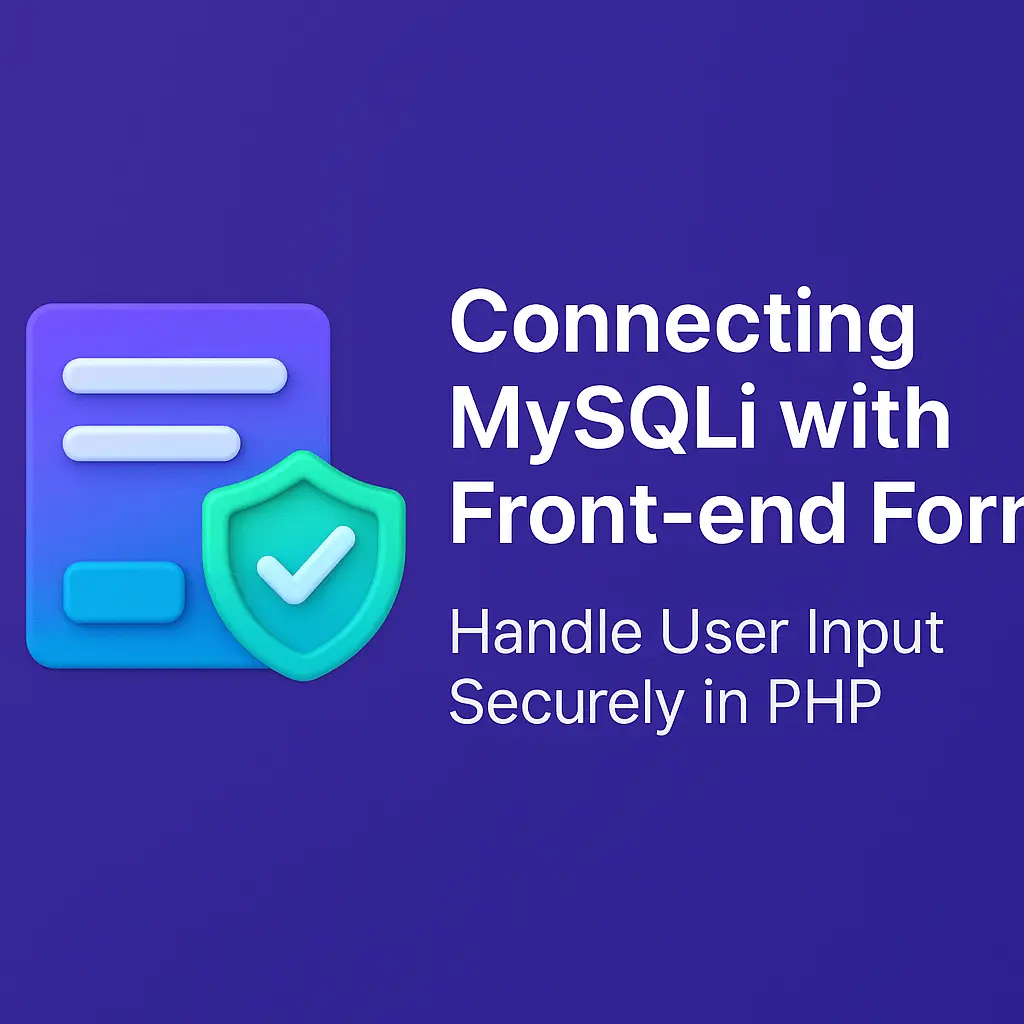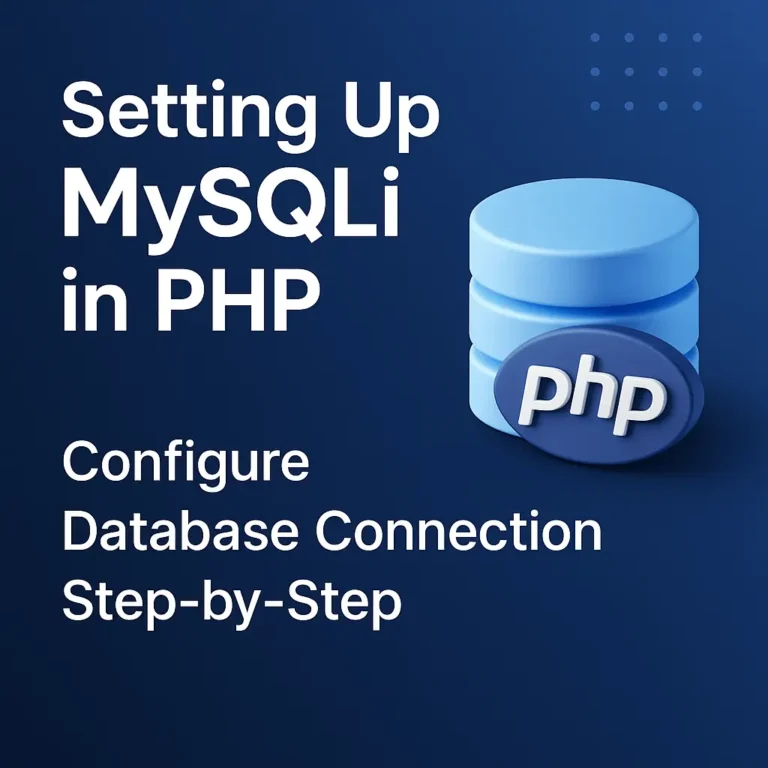This article explores various techniques for integrating MySQLi with front-end forms, providing code examples and best practices to help you achieve robust and secure database interactions.
Understanding the Basics
Before diving into the integration techniques, it’s essential to understand the basic components involved:
- Front-End Form: An HTML form that collects user input.
- Server-Side Script: A PHP script that processes the form data and interacts with the MySQL database using MySQLi.
- MySQL Database: The database where the data submitted via the form will be stored.
Setting Up the Database
Before connecting the front-end form to MySQLi, ensure that your MySQL database is properly set up. Create a database and a table to store the form data.
Example: Creating a MySQL Table
CREATE DATABASE mydatabase;
USE mydatabase;
CREATE TABLE users (
id INT AUTO_INCREMENT PRIMARY KEY,
username VARCHAR(50) NOT NULL,
email VARCHAR(100) NOT NULL,
password VARCHAR(255) NOT NULL,
created_at TIMESTAMP DEFAULT CURRENT_TIMESTAMP
);
Creating the Front-End Form
Design the HTML form that users will interact with. Ensure that the form includes necessary input fields and a submit button.
Example: HTML Form
<!DOCTYPE html>
<html lang="en">
<head>
<meta charset="UTF-8">
<meta name="viewport" content="width=device-width, initial-scale=1.0">
<title>Registration Form</title>
</head>
<body>
<h1>Register</h1>
<form action="process_form.php" method="post">
<label for="username">Username:</label>
<input type="text" id="username" name="username" required><br><br>
<label for="email">Email:</label>
<input type="email" id="email" name="email" required><br><br>
<label for="password">Password:</label>
<input type="password" id="password" name="password" required><br><br>
<button type="submit">Register</button>
</form>
<script>var rocket_lcp_data = {"ajax_url":"https:\/\/codersship.com\/wp-admin\/admin-ajax.php","nonce":"82cc37a6f7","url":"https:\/\/codersship.com\/mysqli\/connecting-mysqli-with-front-end-forms","is_mobile":false,"elements":"img, video, picture, p, main, div, li, svg","width_threshold":1600,"height_threshold":700,"debug":null}</script><script data-name="wpr-lcp-beacon" src='https://codersship.com/wp-content/plugins/wp-rocket/assets/js/lcp-beacon.min.js' async></script></body>
</html>
Processing the Form with PHP and MySQLi
Create a PHP script that processes the form data and inserts it into the MySQL database. This script should include connection handling, data validation, and secure insertion methods.
Example: Processing Form Data
<?php
// Database connection
$servername = "localhost";
$username = "root";
$password = "";
$database = "mydatabase";
// Create connection
$conn = new mysqli($servername, $username, $password, $database);
// Check connection
if ($conn->connect_error) {
die("Connection failed: " . $conn->connect_error);
}
// Get form data
$username = $_POST['username'];
$email = $_POST['email'];
$password = $_POST['password'];
// Validate data
if (empty($username) || empty($email) || empty($password)) {
die("All fields are required.");
}
// Hash the password
$hashed_password = password_hash($password, PASSWORD_BCRYPT);
// Prepare and execute the query
$stmt = $conn->prepare("INSERT INTO users (username, email, password) VALUES (?, ?, ?)");
$stmt->bind_param("sss", $username, $email, $hashed_password);
if ($stmt->execute()) {
echo "Registration successful!";
} else {
echo "Error: " . $stmt->error;
}
// Close the connection
$stmt->close();
$conn->close();
?>
Key Points in the PHP Script:
- Database Connection: Use mysqli to connect to the MySQL database.
- Data Validation: Ensure all fields are filled out before processing.
- Password Hashing: Use password_hash() to securely hash passwords before storing them in the database.
- Prepared Statements: Use prepared statements to prevent SQL injection attacks.
Handling Form Data Securely
Security is crucial when handling user input. Here are some best practices:
Validate and Sanitize Input
Always validate and sanitize user input to prevent malicious data from being processed or stored.
Example: Input Validation and Sanitization
$username = filter_var($_POST['username'], FILTER_SANITIZE_STRING);
$email = filter_var($_POST['email'], FILTER_SANITIZE_EMAIL);
$password = $_POST['password']; // Password should be handled securely
Use Prepared Statements
Prepared statements protect against SQL injection by separating SQL logic from data.
Example: Using Prepared Statements
$stmt = $conn->prepare("INSERT INTO users (username, email, password) VALUES (?, ?, ?)");
$stmt->bind_param("sss", $username, $email, $hashed_password);
Implement CSRF Protection
Cross-Site Request Forgery (CSRF) tokens prevent unauthorized submissions by verifying that the form submission originated from your website.
Example: Adding CSRF Protection
Generate a CSRF Token: Add the token to your form.
session_start();
$_SESSION['csrf_token'] = bin2hex(random_bytes(32));
<input type="hidden" name="csrf_token" value="<?php echo $_SESSION['csrf_token']; ?>">
- Validate the CSRF Token: Check the token on form submission.
session_start();
if ($_POST['csrf_token'] !== $_SESSION['csrf_token']) {
die("Invalid CSRF token.");
}
Handling Errors and Feedback
Providing clear feedback and handling errors effectively improves the user experience.
Display Error Messages
Provide meaningful error messages to help users understand what went wrong.
Example: Displaying Errors
if ($stmt->execute()) {
echo "Registration successful!";
} else {
echo "Error: " . htmlspecialchars($stmt->error);
}
Redirect on Success
Redirect users to a different page or display a success message upon successful form submission.
Example: Redirecting After Success
if ($stmt->execute()) {
header("Location: success.php");
exit();
}
Managing Large Forms and Data
For large forms or extensive data, consider the following strategies:
Use AJAX for Asynchronous Submissions
AJAX allows for asynchronous form submissions without refreshing the page, improving user experience.
Example: AJAX Form Submission
-
HTML Form with AJAX
<form id="registrationForm">
<!-- Form Fields -->
<button type="submit">Register</button>
</form>
<div id="response"></div>
- JavaScript for AJAX
document.getElementById('registrationForm').addEventListener('submit', function(e) {
e.preventDefault();
var formData = new FormData(this);
fetch('process_form.php', {
method: 'POST',
body: formData
})
.then(response => response.text())
.then(data => {
document.getElementById('response').innerHTML = data;
})
.catch(error => {
console.error('Error:', error);
});
});
Implement Pagination for Large Data Sets
If your application handles large amounts of data, use pagination to manage data efficiently.
Example: Implementing Pagination
$limit = 10; // Number of records per page
$page = isset($_GET['page']) ? (int)$_GET['page'] : 1;
$offset = ($page - 1) * $limit;
$sql = "SELECT * FROM users LIMIT ? OFFSET ?";
$stmt = $conn->prepare($sql);
$stmt->bind_param("ii", $limit, $offset);
$stmt->execute();
$result = $stmt->get_result();
Generate Pagination Links
$total_rows = $conn->query("SELECT COUNT(*) FROM users")->fetch_row()[0];
$total_pages = ceil($total_rows / $limit);
for ($i = 1; $i <= $total_pages; $i++) {
echo "<a href='?page=$i'>$i</a> ";
}
Conclusion
Integrating MySQLi with front-end forms is a fundamental skill for web developers. By following best practices and employing secure techniques, you can ensure efficient and secure data handling in your applications. Key aspects include setting up the database, creating and processing forms, implementing security measures, and managing large datasets effectively.
With the techniques outlined in this article, you should be well-equipped to handle form submissions, process user data securely, and manage interactions between your front-end and MySQL database efficiently.






